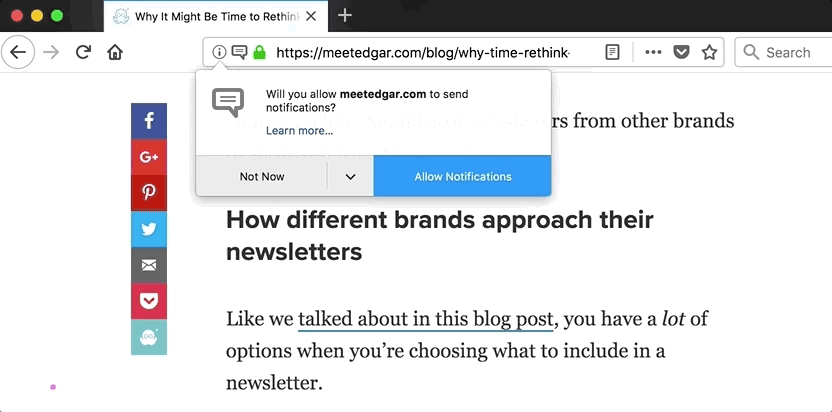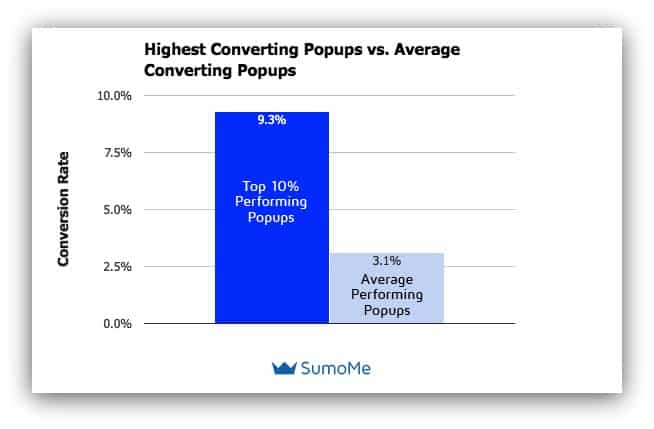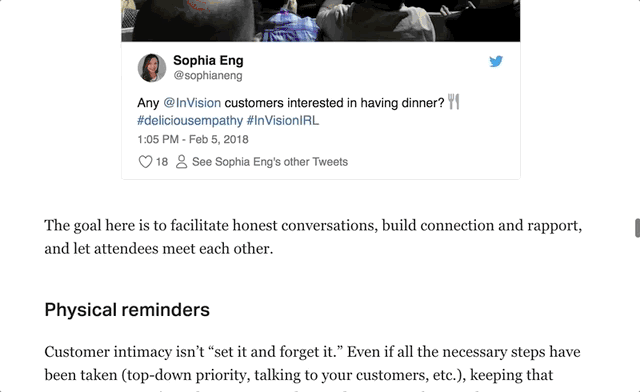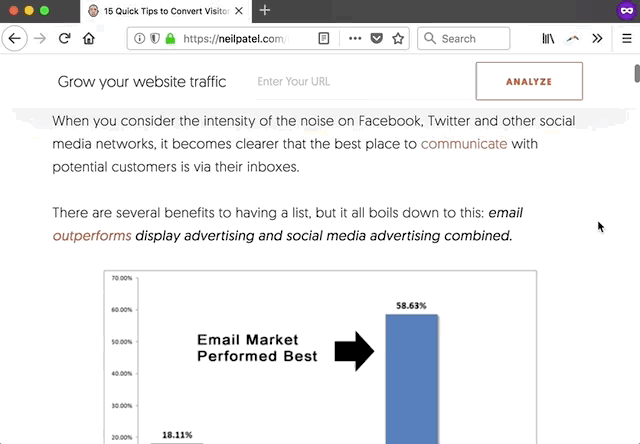Table of Contents:
Do Those Opt-Ins You See Everywhere Actually Work, Or Are They Just Annoying?

Table of Contents:
Raise your hand if this ever happens to you.
(Or don't. We can't really tell either way.)
You're cruising around the web, catching up on your favorite blogs, and suddenly, one of these appears:

Whether or not you EVER actually click on "Allow Notifications," you may wonder from time to time:
Do those web push notifications actually make a difference?
(And if they do, should you offer them on your own website?)Like their spiritual cousin, the pop-up, web push notifications have developed a sort of anecdotal reputation for being annoying - and when you're a marketer, the thought of being annoying is easily as terrifying as that recurring dream where you're falling.(Shudder.)But how much of that reputation is founded in reality?
Does everyone actually hate stuff like this?
Or does avoiding it for the sake of not being annoying actually mean you're missing opportunities?
We'll come back to web push notifications in a second, but as for pop-ups, it turns out that those fears of being annoying aren't necessarily 100% justified.
In 2018, the team over at Sumo analyzed more than 2 billion (with a "b") pop-ups, and it turns out that these things actually work - and they work pretty well.

[Here's some context: according to MailChimp, the average email clickthrough rate across all industries is about 2.61%. According to this Sumo study, the average conversion rate for all pop-ups is about 3.09%.You can dig into the whole study right here - it's packed with amazing tips for creating effective pop-ups - but the short version is that even marketing strategies that feel a little extra can actually make a big difference!
So what's the deal?What makes this sort of thing effective - and how do web push notifications factor in?Let's take a closer look, along with some examples from other brands!
Your site's visitors want more from you
Almost everyone who comes to your site got there on purpose.They were curious about something, and it led them to you, and they actually want to be there.
(You're probably not getting a lot of accidental visitors who slipped a typo into someone else's URL. Though we're sure it happens.)

And while not everyone who visits your site will necessarily want to kick off a long-term relationship with your content - hey, there's no accounting for taste - some of them will!Just like we talked about in this post of tips for writing an email newsletter, when people find your content valuable enough to want more of it, it's your job to make it as easy as possible for them to get it.
That's where something like web push notifications comes in.
As of mid-May 2018, for example, our own blog's opt-in for web push notifications averages about 160 signups per week.(And for a little more context, the click rate for people who receive those notifications actually exceeds our industry's average click rate for emails. The people who choose to receive them really respond to them!)
It might not be a big percentage of our visitors, but over time, it adds up to thousands of people being notified every time we publish a new blog post - and that's not nothing!
Which raises a big question: If stuff like this can actually work really well, why does it feel so...annoying?
Ultimately, it has a lot to do with setting the right expectations for yourself and your audience.
When you implement something like this kind of opt-in, you're not doing it for every last person who visits your site - you're doing it for the visitors who are most interested in what you have to offer!(If you've ever visited a website and been annoyed by the notifications opt-in - yes, even ours - then you're probably not that opt-in's target audience, and that's okay.)
Think of it like this:

Not everybody who would love your content makes it to your site.
Not everybody who makes it to your site wants to opt in for more.
The people who visit your site AND are interested enough to opt in are probably the minority - but that doesn't mean you shouldn't create opportunities for them to get what they want!And since we're on that subject, it's a good opportunity to address not only web push notifications, but pop-ups like we mentioned earlier.
In their study, Sumo provided some powerful in-depth analysis of what makes a pop-up more effective - along with what might make it less effective.
We definitely recommend giving that breakdown a read, but before you do, let's take a quick refresher on some of the different basic types of pop-up your site can offer!
Inspiration for YOUR pop-ups and opt-ins
You already know that promoting a blog post in an email newsletter can send it a nice surge of traffic - so it should come as no surprise that newsletter opt-ins are so popular!(It also shouldn't come as a surprise because you probably see them everywhere you go.)Here's one from the Help Scout blog that slides in as you scroll:

It's simple and straightforward - and as we saw in that same blog post about effective newsletters from before, their emails are, too!
Offering something in addition to your newsletter can make the offer even more compelling.
For example, here's an exit-intent pop-up from Neil Patel:

Getting Neil's SEO cheatsheet as a free resource is fairly compelling - especially because if you're reading his blog, you've already demonstrated interest in improving your online marketing.
Here's another example from our own blog:

Whether it's a standard pop-up, a slide-in, or an exit-intent offer, a free resource like a guide or download might make more sense to your visitors than just signing up for a newsletter.
This sort of thing can offer more than just additional content or resources, too.
For example, take a look at these two pop-ups from the mattress company Leesa:


The first pop-up appears right when you visit their website, and doesn't ask for an email address - it's designed exclusively for someone who is prepared to buy.
The second appears as an exit-intent pop-up, which explains why it asks for more from the visitor - with an email address, Leesa can continue marketing to the visitor after they leave the site.
(Offering a deal also incentivizes visitors to come back, which is especially important considering the likelihood that they're leaving the website to research Leesa's competitors.)
The deals aren't that different, but they're presented at different times, with different messaging, and with different barriers for access.
That kind of fine-tuning can have a lot of influence on the effectiveness of these opt-ins!And speaking of competitors, let's take a look at a different kind of deal from another mattress company, Casper:

A giveaway pop-up like this can show you who's interested in what you have to offer, but not yet interested enough to become a customer.
Every email opt-in is a tool that creates opportunities for long-term nurturing, and this is no different!
Casper can estimate that the number of customers they eventually gain from a promotion like this will be worth the cost of the prize they're giving away - even if it takes a while!(It may also mean that Casper gains customers who didn't necessarily enter, but know people who did. For example, someone who enters this contest may receive a promotional email two months from now that they share with a friend.)
This is just the tip of the iceberg, but it goes to show that opt-ins are their most effective when they offer the right thing at the right time.
Whether it's an opt-in for web push notifications or a pop-up, it has to connect with the people who want and need what you're offering the most - otherwise, it might land itself in that "more annoying than helpful" category.
What do YOU think of opt-ins like these?
Do you ever take them up on the offer? Subscribe to web push notifications? Offer similar opt-ins on your OWN website?
Subscribe to our newsletter
Are you ready to automate your socials?
Say goodbye to manual scheduling and hello to effortless automation.



